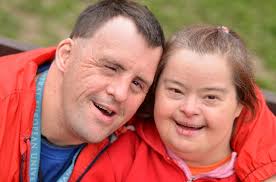Readers Comments 12 Share Your Story
The baby with Down syndrome has a hallmark appearance. However, every aspect of the appearance does not need to be present as the phenotype, the way the genes make the child look, can be markedly different for each patient.
Commonly, there is a small head and short neck, a flat face, and upward slanting eyes. Ears are flat and positioned lower than “normal.” The tongue protrudes and seems to be too large for the mouth. Hands tend to be wide, with short fingers and there is just a single flexion crease in the palm. Joints tend to be more flexible and muscles may lack tone.
The patient may have growth retardation and though as a baby may be normal size, will not grow as tall. Average height for an adult male with Down syndrome is 5 ft 1 in and for a female it is 4 ft 9 in. Bowleggedness is common. Obesity occurs with aging.
There is decreased mental function and the IQ may range from mild disability (50 to 70) to moderate (35 to 50). For patients with Mosaic Down Syndrome, the IQ can be 10 to 30 points higher. There can be language development delay both from hearing impairment and speech delay. Gross motor skills like crawling and walking can be slow to mature and fine motor skills may take time to develop.



 Contact Us
Contact Us







 Hospitals
Hospitals
 Doctors
Doctors
 Diagnostic
Diagnostic
 Pharmacy
Pharmacy
 Health Tips
Health Tips
 Blog
Blog

























Comments